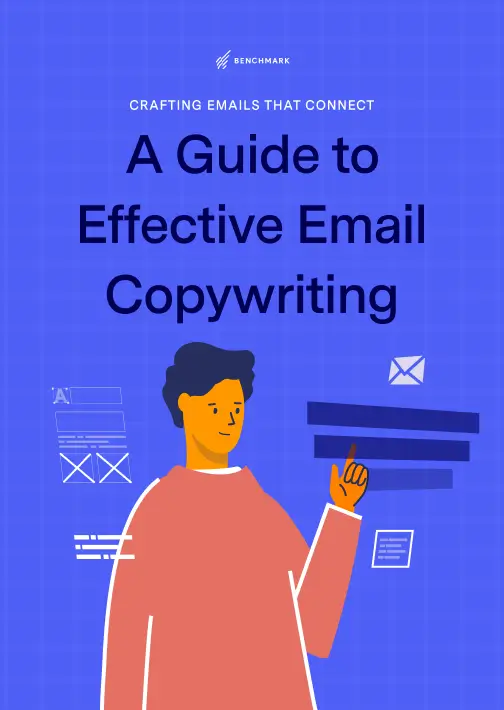The Evolution of Email Marketing: From Plain Text to Interactive Experiences
September 14, 2023 15 min read

Email marketing has traversed a remarkable journey over the years. From its humble beginnings as simple text-based messages to the emergence of dynamic, interactive content, email marketing has undergone a transformation that has revolutionized the way businesses engage with their audiences.
Rewinding the clock, we’ll revisit the era when emails were nothing more than plain, static messages sent to inboxes. The advent of email marketing marked a new dawn for businesses, offering an efficient and cost-effective means of reaching customers directly. However, as inboxes flooded with monotonous and impersonal communications, the need to stand out became evident.
As technology advanced and user preferences evolved, marketers began embracing creativity and innovation to capture their recipients’ attention. We’ll take you through the introduction of images, color schemes, and basic personalization, which heralded a new era of visually appealing email marketing. These developments not only enhanced the aesthetic appeal but also boosted engagement and click-through rates, demonstrating the power of captivating design in email campaigns.
But the transformative journey didn’t stop there. A groundbreaking development was on the horizon: the rise of interactive and dynamic email content. As email clients and web technologies advanced, marketers found ingenious ways to infuse life into their emails. Suddenly, static images gave way to interactive carousels, product galleries, and even personalized video content. Emails ceased to be one-way communications; they became immersive experiences that encouraged recipients to actively participate.
In this article, we’ll shine a spotlight on the adoption of interactive elements like surveys, polls, and quizzes that invite recipients to share their preferences and opinions directly within the email. The power of interactivity as a feedback mechanism became evident, forging deeper connections between businesses and their audiences.
As the story unfolds, we explore the game-changing introduction of real-time content in emails. Dynamic content tailored to individual preferences and behavior became the norm. From personalized product recommendations to live countdown timers, email marketing embraced a level of relevance and immediacy that was unprecedented.
Our journey culminates in the present-day landscape of email marketing, where AI-powered technologies, AMP for Email, and immersive AR experiences have taken center stage. We delve into how these cutting-edge advancements redefine email marketing, further blurring the lines between email and personalized web experiences.
Join us as we navigate the exciting history and transformation of email marketing, as well as how businesses have embraced innovation to create engaging email experiences and discover the boundless possibilities that await in the ever-evolving world of email marketing.

The Early Days of Email Marketing
Email marketing finds its roots in the early days of the Internet when email was primarily used for communication among researchers and scientists. However, it didn’t take long for businesses to recognize the potential of email as a direct marketing tool. In the late 1970s and early 1980s, a few trailblazing companies began experimenting with sending promotional messages via email to reach potential customers.
In the early days, email marketing was a simple and straightforward affair. Most email campaigns consisted of plain text messages without any graphics or formatting. Despite the lack of visual appeal, plain text emails proved to be remarkably effective in capturing the attention of recipients. The novelty of receiving personalized messages directly in their inboxes led to high open rates and engagement levels. The ability to reach a large audience instantly and at a minimal cost made email marketing an attractive option for businesses.
As email marketing gained momentum, it also encountered several challenges and limitations. One of the most significant hurdles was the issue of spam. As email became more popular as a marketing channel, unsolicited and irrelevant messages flooded users’ inboxes, leading to a negative perception of email marketing.
Another challenge was the lack of advanced email delivery and tracking systems. Marketers had limited insights into email performance, making it difficult to measure the effectiveness of their campaigns accurately. This lack of data made it challenging to optimize marketing strategies and target the right audience effectively.
Furthermore, the early days of email marketing lacked personalization and segmentation capabilities. Most campaigns were sent as mass emails, lacking the ability to tailor content to individual recipients’ preferences and needs. This one-size-fits-all approach often led to lower engagement rates and limited customer response.
Moreover, the technical limitations of email clients and server capacities also posed challenges. Email marketers had to ensure that their messages were displayed correctly across various email platforms and devices, a task that required testing and adjustments to ensure a consistent user experience.
Despite these challenges, the potential of email marketing was evident. As technology advanced and marketers learned from their experiences, email marketing evolved into a more sophisticated and effective marketing channel, embracing personalization, interactive content, and advanced analytics. The early days of email marketing laid the foundation for the dynamic and engaging email campaigns we see today, marking it as a cornerstone of modern digital marketing strategies.
The Rise of HTML Emails
The introduction of HTML (Hypertext Markup Language) emails revolutionized email marketing by allowing for richer and more visually appealing content. Unlike plain text emails, HTML emails enable marketers to incorporate images, colors, fonts, and formatting, making emails more engaging and aesthetically pleasing. This shift had a profound impact on email design, as marketers could now create captivating and immersive experiences for their recipients.
With HTML emails, marketers could convey their brand identity and message more effectively through images and formatting. They could use eye-catching graphics, banners, and product images to showcase their offerings, making emails more visually enticing. Formatting options such as bold text, bullet points, and headings allowed for better organization and readability, improving the overall communication of the email’s content.
Advantages of HTML Emails in Marketing Campaigns
- Visual Appeal: HTML emails are visually appealing, allowing businesses to create stunning designs that capture the attention of recipients and convey brand aesthetics effectively.
- Branding: HTML emails enable consistent branding with the use of logos, brand colors, and fonts, reinforcing brand identity and recognition.
- Enhanced Communication: HTML emails support multimedia elements, such as videos and GIFs, allowing marketers to deliver dynamic and interactive content to engage recipients.
- Call-to-Action (CTA) Emphasis: HTML emails allow for prominent and stylized CTAs, encouraging recipients to take desired actions, such as making a purchase or signing up for an event.
- Tracking and Analytics: HTML emails enable tracking of open rates, click-through rates, and user interactions, providing valuable data for campaign analysis and optimization.
- Personalization: HTML emails support dynamic content, enabling marketers to personalize emails based on recipient data, increasing relevance and engagement.
Disadvantages of HTML Emails in Marketing Campaigns:
- Rendering Issues: HTML emails may display differently across various email clients and devices, leading to rendering issues and inconsistent user experiences.
- Code Complexity: HTML emails require proper coding and testing to ensure they display correctly, leading to increased development time and potential coding errors.
- Accessibility Challenges: Some visually impaired users may have difficulty accessing and understanding HTML emails, as they heavily rely on images and formatting.
- Spam Filters: HTML emails may trigger spam filters if they contain certain elements or characteristics commonly associated with spam.
- Larger File Sizes: HTML emails with images and multimedia elements can have larger file sizes, leading to longer loading times for recipients with slower internet connections.
- Mobile Optimization: Ensuring that HTML emails are optimized for mobile devices is essential, as emails that are not mobile-friendly may result in lower engagement on mobile platforms.
HTML emails have significantly transformed email marketing by providing marketers with a canvas for creativity and communication. While they offer numerous advantages in terms of design and engagement, marketers must carefully consider rendering issues, code complexity, and accessibility to ensure a successful email marketing campaign. With strategic planning and optimization, HTML emails can become powerful tools for building meaningful connections with recipients and driving successful marketing outcomes.
Interactive Elements Enter the Scene
The advent of interactive elements in email marketing represents a pivotal shift in how marketers engage with their audiences. As consumers became more tech-savvy and demanded immersive experiences, static and one-dimensional emails could no longer fully capture their attention. The introduction of interactive elements allowed for two-way communication, transforming emails from passive messages into interactive and engaging experiences.
Early Implementations of Interactive Features
- Click-to-Reveal Content: One of the early implementations of interactivity in emails was the “click-to-reveal” feature. This allowed marketers to hide content behind buttons or icons, enticing recipients to click for more information or special offers. Click-to-reveal elements increased user engagement and provided a sense of discovery, encouraging recipients to take action within the email itself.
- Image Carousels: Image carousels bring dynamic content to emails, allowing marketers to showcase multiple products or offers within a single space. Recipients could scroll through images or offers by clicking arrows or swiping, making the email feel like an interactive and personalized experience.
- Surveys and Polls: Including surveys and polls directly in emails enabled marketers to gather feedback and opinions from recipients easily. This real-time interactivity allowed businesses to gain insights into customer preferences, enhancing personalization and tailoring future campaigns accordingly.
- Interactive Menus and Navigation: Interactive menus and navigation elements enabled recipients to explore different sections or products within the email. Marketers could segment content based on user interests, making the email more relevant and engaging.
Initial Challenges in Rendering Interactive Elements Across Different Email Clients:
While interactive elements brought numerous benefits to email marketing, they also presented challenges, particularly in rendering consistency across different email clients and devices:
- Limited Support: Different email clients and platforms had varying levels of support for HTML and CSS features, leading to inconsistent rendering of interactive elements. Some interactive features that worked well on one email client might not function correctly on another.
- Mobile Responsiveness: Ensuring that interactive elements were responsive on mobile devices was challenging due to the wide range of screen sizes and resolutions. Elements that worked seamlessly on desktops might not function optimally on mobile platforms.
- Security Concerns: Some interactive elements, such as embedded videos or certain scripts, were often blocked by email clients for security reasons, preventing recipients from fully experiencing the intended interactivity.
- Code Complexity: Creating interactive elements required complex coding, increasing the likelihood of coding errors and rendering issues across different email clients.
- Testing and Compatibility: Testing interactive elements across multiple email clients and devices was time-consuming and resource-intensive, as each combination required individual attention to ensure proper functionality.
Despite these challenges, marketers recognized the immense potential of interactive elements in email marketing. As technology and email standards evolved, email clients began to offer better support for interactive features, and responsive design techniques emerged to address mobile compatibility issues. Today, interactive elements have become a powerful tool for engaging recipients, fostering brand interactions, and enhancing the overall effectiveness of email marketing campaigns.
The Power of Dynamic Email Content
Dynamic email content refers to email elements that change and adapt based on the recipient’s behavior, preferences, or real-time data. Unlike static email content, which remains the same for all recipients, dynamic content allows marketers to personalize and tailor the email experience for each individual, making it more relevant and engaging.
Why Dynamic Email Content is Powerful
- Personalization: Dynamic email content enables personalized experiences, where each recipient receives content that resonates with their specific interests, preferences, and past interactions with the brand. This personal touch fosters a stronger connection with the recipient and enhances the overall user experience.
- Relevance: By delivering content that is relevant to the recipient’s needs and stage in the customer journey, dynamic emails are more likely to capture attention and drive action. The content feels timely and useful, increasing the chances of engagement and conversions.
- Increased Engagement: Interactivity and real-time updates in dynamic emails make them more engaging than static messages. The ability to interact with content, such as clicking on personalized product recommendations or completing surveys within the email, encourages recipients to stay longer and take desired actions.
- Live Updates: Dynamic content can display live and up-to-date information, such as real-time pricing, availability, or event countdowns. This creates a sense of urgency and excitement, motivating recipients to act promptly.
- A/B Testing: Dynamic content allows marketers to conduct A/B testing within emails, testing different variations of elements and measuring their impact on recipient engagement. This data-driven approach helps optimize email performance and identify the most effective content.
- Time-Sensitivity: Dynamic emails can incorporate time-sensitive content, such as limited-time offers or flash sales. The urgency created by such content can drive recipients to act quickly and take advantage of the opportunity.

Role in Personalized Experiences
Dynamic email content plays a critical role in delivering personalized experiences to recipients. It enables marketers to leverage recipient data, such as browsing behavior, purchase history, location, and preferences, to craft tailored content. This personalization can be achieved through dynamic product recommendations, location-specific offers, personalized subject lines, and targeted content blocks based on past interactions.
Dynamic content also extends to email automation and triggered campaigns. Recipients can receive emails triggered by specific actions or events, such as abandoned cart emails, order confirmation emails, or birthday greetings. These automated emails can include personalized content relevant to the trigger event, enhancing the sense of relevance and personal touch.
Moreover, dynamic email content integrates with other marketing efforts, such as website personalization and customer segmentation. By unifying data across multiple touchpoints, marketers can create consistent and seamless personalized experiences that span the entire customer journey.
Leveraging User-Generated Content
User-generated content (UGC) refers to content created and shared by customers, such as reviews, testimonials, photos, videos, and social media posts. Integrating UGC in email marketing campaigns involves leveraging this authentic content to enhance the overall effectiveness and engagement of the emails.
Harnessing the Power of Social Proof and Customer Advocacy through UGC
- Social Proof: UGC serves as powerful social proof for a brand’s products or services. When potential customers see real people sharing positive experiences, it instills trust and confidence in the brand. Including UGC in emails, such as testimonials or customer reviews, can influence recipients’ purchasing decisions and encourage them to engage with the brand.
- Authenticity: UGC is inherently authentic and relatable. As it comes directly from customers, it resonates with the audience on a more emotional level compared to traditional marketing content. This authenticity helps build a stronger connection with the brand and fosters a sense of community among customers.
- Customer Advocacy: By featuring UGC in emails, brands can transform satisfied customers into advocates. When customers see their content being shared by the brand, they feel valued and appreciated. This can lead to increased brand loyalty and the likelihood of customers promoting the brand to their networks.
- Diversified Content: UGC adds variety and diversity to email content. Instead of relying solely on promotional messages or brand-generated content, UGC brings a fresh perspective and a human touch to the emails, making them more engaging and captivating.
- Increased Engagement: UGC is inherently engaging, as it captures real moments and experiences. Incorporating UGC in emails, such as showcasing customer photos or videos, encourages recipients to interact with the content and the brand, leading to higher click-through rates and longer email engagement.
- Enhanced Personalization: UGC allows for a higher level of personalization in emails. By tailoring UGC to specific segments or user behaviors, brands can create hyper-targeted email campaigns that align with recipients’ interests and preferences.
- Fostering User-Generated Content: Email marketing can also be used strategically to encourage customers to create and share UGC. For example, brands can run contests, surveys, or ask for product reviews and testimonials through email campaigns, thus generating more UGC for future marketing efforts.
- Leveraging Social Media Impact: UGC often originates from social media platforms where customers share their experiences with the brand. Integrating UGC from social media into email campaigns bridges the gap between these two channels and maximizes the impact of customer advocacy.
AMP for Email: A Game-Changer
Accelerated Mobile Pages (AMP) for Email is an extension of the AMP project by Google that aims to enhance the performance and interactivity of emails on mobile devices. It allows email marketers and developers to create more engaging, dynamic, and interactive experiences directly within emails, providing recipients with a seamless and responsive user experience.
Benefits of AMP for Email in Creating Interactive and Dynamic Experiences
- Interactivity: AMP for Email enables interactive elements, such as image carousels, accordions, and quizzes, within the email itself. Recipients can engage with the content, view additional images or information, and interact with the email without leaving their inbox.
- Real-Time Content: With AMP for Email, marketers can display real-time content that updates dynamically, providing recipients with the latest information. For example, email content can show live sports scores, upcoming event schedules, or flight status updates.
- Forms and Surveys: AMP for Email supports interactive forms and surveys, enabling recipients to submit responses and feedback directly within the email. This enhances user engagement and simplifies the process of collecting user data.
- Personalization: AMP for Email allows for more personalized and relevant content, as it can dynamically display content based on recipient data or behavior. This level of personalization creates a more tailored and compelling experience for recipients.
- Faster Load Times: AMP for Email is designed to improve email performance and load times, particularly on mobile devices. The streamlined coding and reduced reliance on external resources contribute to a faster and more responsive email experience.
- Seamless Navigation: With AMP for Email, recipients can navigate between different sections of an email using anchor links. This feature simplifies the user experience, making it easier for recipients to access specific content within the email.
- Improved Click-through Rates: The interactivity and dynamic content offered by AMP for Email can lead to higher click-through rates. Recipients are more likely to engage with and explore the email content, increasing the chances of driving traffic to the brand’s website or landing pages.
- Simplified Checkout Process: AMP for Email supports actionable elements, such as adding items to a cart or completing a purchase, directly within the email. This streamlines the checkout process, reducing friction and increasing conversion rates.
- Better User Experience: The enhanced interactivity and dynamic features provided by AMP for Email create a more enjoyable and immersive user experience. This positive experience fosters stronger connections with the brand and enhances overall brand perception.
- Cross-Platform Compatibility: AMP for Email is designed to work across different email clients and devices, ensuring a consistent experience for recipients regardless of the email platform they use.
AMP for Email brings a range of benefits to email marketing by enabling more interactive and dynamic experiences. With real-time content, personalized elements, and faster load times, AMP for Email elevates email campaigns to new levels of engagement and effectiveness, allowing marketers to deliver more compelling and relevant content directly to recipients’ inboxes.
The Future of Email Marketing: Personalized and Immersive Experiences
Email marketing continues to evolve, adapting to changes in consumer behavior, technology advancements, and regulatory landscapes. As we look ahead, several trends and developments are likely to shape the future of email marketing:
Hyper-Personalization
The future of email marketing lies in hyper-personalization, where emails are tailored to individual preferences, behaviors, and needs. Artificial intelligence (AI) and machine learning will play a crucial role in analyzing vast amounts of data to deliver highly targeted and relevant content to recipients.
AI-Driven Email Automation
AI will enhance email automation, allowing marketers to create sophisticated automated workflows that respond to user interactions and trigger personalized emails at the right moments in the customer journey. AI will optimize send times, subject lines, and content, ensuring better engagement and conversions.
Predictive Analytics
Predictive analytics will gain prominence in email marketing, enabling marketers to anticipate customer actions and preferences. By leveraging AI and historical data, marketers can predict the most effective content and offers for each recipient.
Interactive and Immersive Experiences
The use of interactive content, such as AMP for Email, will become standard practice. Marketers will create immersive experiences within emails, allowing recipients to interact with content, complete actions, and make purchases without leaving their inboxes.
Video and Live Content
Video content is extremely popular and will only become more popular with email marketing as well. HTML5 video elements will deliver engaging and dynamic experiences to recipients, while live streaming within emails will bring real-time events and experiences directly to the inbox.
Mobile Optimization
With the increasing use of mobile devices, email marketing will prioritize mobile optimization to deliver seamless experiences on smaller screens. Responsive design and AMP for Email will ensure that emails are tailored to various mobile platforms.
Email Accessibility
Brands will focus on making emails more accessible to users with disabilities, ensuring that all recipients can engage with content easily. This includes using alt text for images, clear call-to-action buttons, and readable fonts.
Enhanced Security and Privacy
As data privacy concerns grow, email marketers will adopt more robust security measures to protect customer data and comply with evolving privacy regulations. Building trust through transparency will be crucial.
Omni-Channel Integration
Email marketing will integrate with other marketing channels, such as social media, websites, and apps, to provide consistent and cohesive customer experiences across touchpoints.
Data-Driven Decisions
Marketers will increasingly rely on data-driven decision-making, using analytics and insights to refine email strategies, improve performance, and achieve better ROI.







